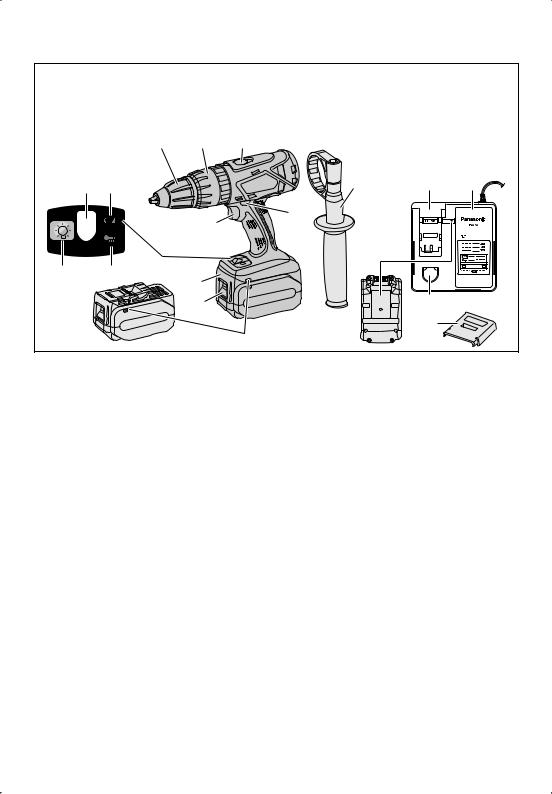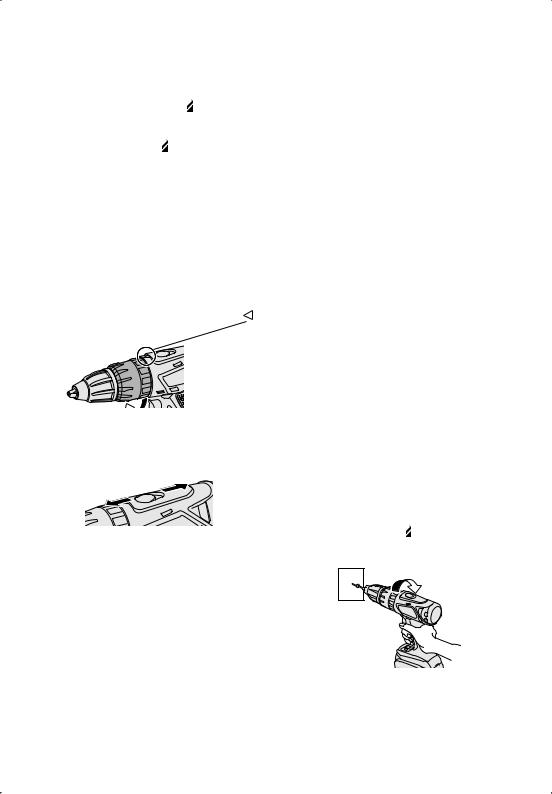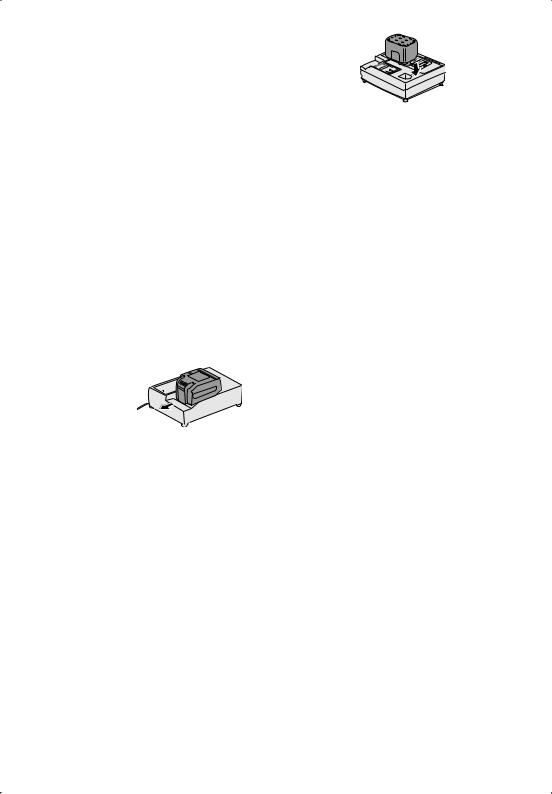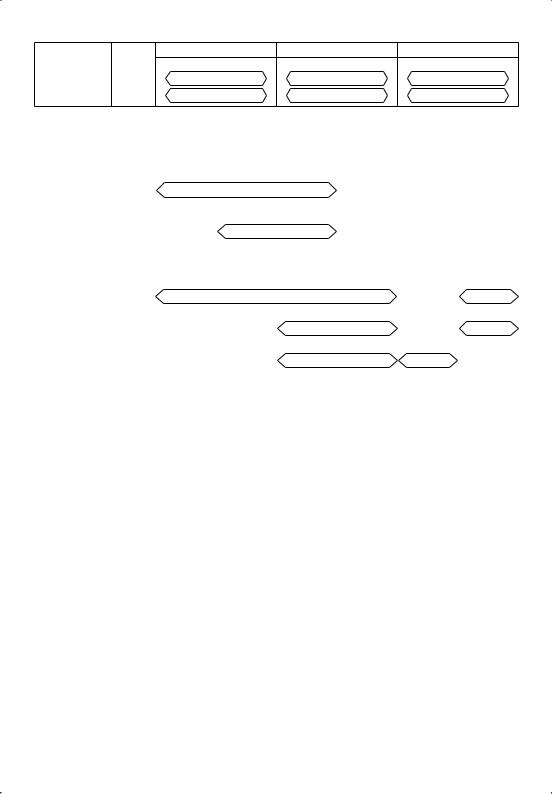Panasonic EY7960, EY7460 User Manual

Cordless Drill & Driver/Cordless Hammer Drill & Driver Perceuse-visseuse sans fil/Perceuse à percussion-visseuse sans fil Destornillador y taladro sin cables/Destornillador y taladro percutor sin cables
Operating Instructions
Instructions d'utilisation
Manual de instrucciones
Model No: EY7460/EY7960
IMPORTANT
This manual contains safety information. Read manual completely before first using this product and save this manual for future use.
IMPORTANT
Ce mode d’emploi contient des informations sur la sécurité. Lisez-le en entier avant d’utiliser le produit et conservez-le pour référence.
IMPORTANTE
Este manual contiene información de seguridad. Lea completamente este manual antes de utilizar por primera vez este producto, y guárdelo para poder consultarlo en el futuro.

Index/Index/Indice |
|
|
|
|
|
||
English: Page 3 |
Français: Page 15 |
Español: Página 30 |
|
|
|||
FUNCTIONAL DESCRIPTION |
|
|
|||||
DESCRIPTION DES FONCTIONS |
|
|
|||||
DESCRIPCIÓN FUNCIONAL |
|
|
|||||
|
|
(A) |
(B) |
(C) |
|
|
|
(K) |
(L) |
|
|
|
(N) |
(R) |
(O) |
|
|
|
|
||||
|
|
|
|
|
|
||
|
|
|
(M) |
|
(D) |
|
|
|
|
|
|
|
|
|
|
|
|
|
|
|
(E) |
|
|
(J) |
(I) |
(H) |
|
|
|
|
|
|
|
|
|
|
|
||
|
|
|
(G) |
|
|
|
Ni-MH |
|
|
|
|
|
|
Ni-Cd |
|
|
|
|
(F) |
|
|
(Q) |
|
|
|
|
|
|
|
|
|
|
|
|
|
|
|
(P) |
|
|
|
|
|
(E) |
|
|
|
(A) |
Keyless drill chuck |
Mandrin porte-foret sans fil |
Mandril sin llave |
|
(B) |
Clutch handle |
Poignée de l’embrayage |
Mango de embrague |
|
(C) |
Speed selector switch |
Interrupteur de sélection de vitesse |
Interruptor selector de velocidad |
|
(D) |
Forward/Reverse lever |
Levier d’inversion marche |
Palanca de avance/inversión |
|
avant-marche arrière |
||||
|
|
|
||
(E) |
Alignment marks |
Marques d’alignement |
Marcas de alineación |
|
(F) |
Battery pack release button |
Bouton de libération de |
Botón de liberación de batería |
|
batterie autonome |
||||
|
|
|
||
(G) |
Battery pack (EY9L60) |
Batterie autonome (EY9L60) |
Batería (EY9L60) |
|
(H) |
Control panel |
Panneau de commande |
Panel de controle |
|
(I) |
Overheat warning lamp |
Témoin d’avertissement de |
Luz de advertencia de sobre- |
|
(battery/motor) |
surchauffe (batterie/moteur) |
calentamiento (batería/motor) |
||
(J) |
LED light on/off button |
Bouton Marche/Arrêt de la |
Botón ON/OFF de luz LED |
|
lumière DEL |
||||
|
|
|
||
(K) |
LED light |
Lumière DEL |
Luz indicadora |
|
(L) |
Battery low warning lamp |
Témoin d’avertissement de |
Luz de aviso de baja carga de |
|
batterie basse |
batería |
|||
|
|
|||
(M) |
Variable speed control trigger |
Gâchette de commande de |
Disparador del control de |
|
vitesse |
velocided variable |
|||
(N) |
Support handle |
Manche de support |
Mango de soporte |
|
(O) |
Battery charger (EY0L80) |
Chargeur de batterie (EY0L80) |
Cargador de batería (EY0L80) |
|
(P) |
Battery Pack cover |
Couvercle de la batterie |
Cubierta de batería |
|
autonome |
||||
|
|
|
||
(Q) |
Ni-MH/Ni-Cd battery pack |
Poste d’accueil de la batterie |
Enchufe de carga de batería |
|
dock |
autonome Ni-MH/Ni-Cd |
Ni-MH/Ni-Cd |
||
(R) |
Li-ion battery pack dock |
Poste d’accueil de la batterie |
Enchufe de carga de batería |
|
autonome Li-ion |
Li-ión |
|||
|
|
- 2 -

I. INTRODUCTION
These tools can be used to tighten screws in clutch mode and to drill holes in wood and metal in drill mode. Additionally, model EY7960 can be used to drill holes in soft concrete and similar materials in hammer mode.
II.GENERAL SAFETY RULES
 WARNING! Read all instructions
WARNING! Read all instructions
Failure to follow all instructions listed below may result in electric shock, fire and/or serious injury. The term “power tool” in all of the warnings listed below refers to your main operated (corded) power tool and battery operated (cordless) power tool.
SAVE THESE INSTRUCTIONS
Work Area Safety
1)Keep work area clean and well lit.
Cluttered or dark areas invite accidents.
2)Do not operate power tools in explosive atmospheres, such as in the presence of flammable liquids, gases or dust.
Power tools create sparks which may ignite the dust or fumes.
3)Keep children and bystanders away while operating a power tool.
Distractions can cause you to lose control.
Electrical Safety
1)Power tool plugs must match the outlet. Never modify the plug in any way. Do not use any adapter plugs with earthed (grounded) power tools.
Unmodified plugs and matching outlets will reduce risk of electric shock.
2)Avoid body contact with earthed or grounded surfaces such as pipes, radiators, ranges and refrigerators.
There is an increased risk of electric shock if your body is earthed or grounded.
3)Do not expose power tools to rain or wet conditions.
Water entering a power tool will increase the risk of electric shock.
4)Do not abuse the cord. Never use the cord for carrying, pulling or unplugging the power tool. Keep cord away from heat, oil, sharp edges or moving parts.
Damaged or entangled cords increase the risk of electric shock.
5)When operating a power tool outdoors, use an extension cord suitable for outdoor use.
Use of a cord suitable for outdoor use reduces the risk of electric shock.
Personal Safety
1)Stay alert, watch what you are doing and use common sense when operating a power tool. Do not use a power tool while you are tired or under the influence of drugs, alcohol or medication.
A moment of inattention while operating power tools may result in personal injury.
2)Use safety equipment. Always wear eye protection.
Safety equipment such as dust mask, non-skid safety shoes, hard hat, or hearing protection used for appropriate conditions will reduce personal injuries.
3)Avoid accidental starting. Ensure the switch is in the off position before plugging in.
Carrying power tools with your finger on the switch or plugging in the power tools that have the switch on invites accidents.
4)Remove any adjusting key or wrench before turning the power tool on.
A wrench or a key left attached to a rotating part of the power tool may result in personal injury.
5)Do not overreach. Keep proper footing and balance at all times.
This enables better control of the power tool in unexpected situations.
6)Dress properly. Do not wear loose clothing or jewelry. Keep your hair, clothing and gloves away from moving parts.
Loose clothes, jewelry or long hair can be caught in moving parts.
- 3 -

7)If devices are provided for the connection of dust extraction and collection facilities, ensure these are connected and properly used.
Use of these devices can reduce dust related hazards.
Power Tool Use and Care
1)Do not force the power tool. Use the correct power tool for your application.
The correct power tool will do the job better and safer at the rate for which it was designed.
2)Do not use the power tool if the switch does not turn it on and off.
Any power tool that cannot be controlled with the switch is dangerous and must be repaired.
3)Disconnect the plug from the power source and/or the battery pack from the power tool before making any adjustments, changing accessories, or storing power tools.
Such preventive safety measures reduce the risk of starting the power tool accidentally.
4)Store idle power tools out of the reach of children and do not allow persons unfamiliar with the power tool or these instructions to operate the power tool.
Power tools are dangerous in the hands of untrained users.
5)Maintain power tools. Check for misalignment or binding of moving parts, breakage of parts and any other condition that may affect the power tools operation. If damaged, have the power tool repaired before use.
Many accidents are caused by poorly maintained power tools.
6)Keep cutting tools sharp and clean.
Properly maintained cutting tools with sharp cutting edges are less likely to bind and are easier to control.
7)Use the power tool, accessories and tool bits etc. in accordance with these instructions and in the manner intended for the particular type of power tool, taking into account the working conditions and the work to be performed.
Use of the power tool for operations different from those intended could result in a hazardous situation.
Battery Tool Use and Care
1)Ensure the switch is in the off position before inserting battery pack.
Inserting battery pack into power tools that have the switch on invites accidents.
2)Recharge only with the charger specified by the manufacturer.
A charger that is suitable for one type of battery pack may create a risk of fire when used with another battery pack.
3)Use power tools only with specifically designated battery packs.
Use of any other battery packs may create a risk of injury and fire.
4)When battery pack is not in use, keep it away from other metal objects like paper clips, coins, keys, nails, screws, or other small metal objects that can make a connection from one terminal to another.
Shorting the battery terminals together may cause burns, or a fire.
5)Under abusive conditions, liquid may be ejected from battery; avoid contact. If contact accidentally occurs, flush with water. If liquid contacts eyes, additionally seek medical help.
Liquid ejected from the battery may cause irritation or burns.
Service
1)Have your power tool serviced by a qualified repair person using only identical replacement parts.
This will ensure that the safety of power tool is maintained.
III. SPECIFIC SAFETY RULES
1)Wear ear protectors. Exposure to noise can cause hearing loss.
2)Use auxiliary handles supplied with the tool. Loss of control can cause personal injury.
- 4 -

3)Hold power tools by insulated gripping surfaces when performing an operation where the cutting tool may contact hidden wiring.
Contact with a “live” wire will make exposed metal parts of the tool “live” and shock the operator.
4)Be aware that this tool is always in an operating condition, since it does not have to be plugged into an electrical outlet.
5)If the bit becomes jammed, immediately turn the trigger switch off to prevent an overload which can damage the battery pack or motor. Use reverse motion to loosen jammed bits.
6)Do not operate the Forward/Reverse lever when the trigger switch is on. The battery will discharge rapidly and damage to the unit may occur.
7)When storing or carrying the tool, set the Forward/Reverse lever to the center position (switch lock).
8)Do not strain the tool by holding the speed control trigger halfway (speed control mode) so that the motor stops. The protection circuit will activate and may prevent speed control operation. If this happens, release the speed control trigger and squeeze again for normal operation.
9)Be careful not to get dust inside the chuck.
10)Do not touch the rotating parts to avoid injury.
11)Do not use the tool continuously for a long period of time. Stop using the tool from time to time to avoid temperature rise and heat overload of the motor.
12)Do not drop the tool.
13)Wear dust mask, if the work causes dust.
14)During charging, the charger may become slightly warm. This is normal. Do NOT charge the battery for a long period.
Symbol |
meaning |
||||||
|
|
V |
Volts |
||||
|
|
|
|
|
|
|
|
|
|
|
|
|
|
|
Direct current |
|
|
|
|
|
|
|
|
|
|
|
|
|
|
|
|
|
|
n0 |
No load speed |
||||
|
|
|
|
|
|
|
|
… min-1 |
Revolutions or |
||||||
|
|
|
|
|
|
|
reciprocation per minutes |
|
Ah |
Electrical capacity of |
|||||
|
battery pack |
||||||
|
|
|
|
|
|
|
|
|
|
|
|
|
|
|
Forward rotation |
|
|
|
|
|
|
|
|
|
|
|
|
|
|
|
Reverse rotation |
|
|
|
|
|
|
|
|
|
|
|
|
|
|
|
Rotation with hammering |
|
|
|
|
|
|
|
|
|
|
|
|
|
|
|
|
|
|
|
|
|
|
|
Rotation only |
|
|
|
|
|
|
|
|
 WARNING:
WARNING:
Some dust created by power sanding, sawing, grinding, drilling, and other construction activities contains chemicals known to the State of California to cause cancer, birth defects or other reproductive harm. Some examples of these chemicals are:
*Lead from lead-based paints
*Crystalline silica from bricks and cement and other masonry products
*Arsenic and chromium from chem- ically-treated lumber.
To reduce your exposure to these chemicals: work in a well ventilated area, and work with approved safety equipment, such as dust masks that are specially designed to filter the microscopic particles.
- 5 -

IV. FOR BATTERY C H A R G E R & BATTERY PACK
Important Safety Instructions
1)SAVE THESE INSTRUCTIONS -This manual contains important safety and operating instructions for battery charger EY0L80.
2)Before using battery charger, read all instructions and cautionary markings on (1) battery charger, (2) battery pack.
3)CAUTION - To reduce the risk of injury, charge only Panasonic Battery Pack as shown in last page.
Other types of batteries may burst causing personal injury and damage.
4)Do not expose charger to rain or snow.
5)To reduce the risk of damaging the electric plug and cord, pull by plug rather than cord when disconnecting charger.
6)Make sure cord is located so that it will not be stepped on, tripped over, or otherwise subjected to damage or stress.
7)An extension cord should not be used unless absolutely necessary. Use of improper extension cord could result in a risk of fire and electric shock. If extension cord must be used, make sure:
a.that pins on plug of extension cord are the same number, size and shape as those of plug on charger.
b.that extension cord is properly wired and in good electrical condition.
c.that wire size is large enough for ampere rating of charger as specified below.
RECOMMENDED MINIMUM AWG SIZE OF
EXTENSION CORDS FOR
BATTERY CHARGERS
AC Input Rating. |
Amperes |
AWG Size of Cord |
|||
Equal to or |
But less |
Length of Cord, Feet |
|||
greater than |
than |
25 |
50 |
100 150 |
|
0 |
2 |
18 |
18 |
18 |
16 |
8)Do not operate charger with damaged cord or plug replace them immediately.
9)Do not operate charger if it has received a sharp blow, been dropped, or otherwise damaged in any way; take it to a qualified serviceman.
10)Do not disassemble charger; take it to a qualified serviceman when service or repair is required. Incorrect reassembly may result in a risk of electric shock or fire.
11)To reduce the risk of electric shock, unplug charger from outlet before attempting any maintenance or cleaning.
12)The charger and battery pack are specifically designed to work together. Do not attempt to charge any other cordless tool or battery pack with this charger.
13)Do not attempt to charge the battery pack with any other charger.
14)Do not attempt to disassemble the battery pack housing.
15)Do not store the tool and battery pack in locations where the temperature may reach or exceed 50°C (122°F) (such a metal tool shed, or a car in the summer), which can lead to deterioration of the storage battery.
16)Do not charge battery pack when the temperature is BELOW 0°C (32°F) or ABOVE 40°C (104°F). This is very important.
17)Do not incinerate the battery pack. It can explode in a fire.
18)Avoid dangerous environment. Do not use charger in damp or wet locations.
19)The charger is designed to operate on standard household electrical power only. Do not attempt to use it on any other voltage!
20)Do not abuse cord. Never carry charger by cord or yank it to disconnect from outlet. Keep cord away from heat, oil and sharp edges.
21)Charge the battery pack in a well ventilated place, do not cover the charger and battery pack with a cloth, etc., while charging.
22)Use of an attachment not recommended may result in a risk of fire, electric shock, or injury to persons.
- 6 -

23)Do not short the battery pack. A battery short can cause a large current flow, over heating and burns.
24)NOTE: If the supply cord of this appliance is damaged, it must only be replaced by a repair shop appointed by the manufacturer, because special purpose tools are required.
25)TO REDUCE THE RISK OF ELECTRIC SHOCK, THIS APPLIANCE HAS A POLARIZED PLUG (ONE BLADE IS WIDER THAN THE OTHER).
This plug will fit in a polarized outlet only one way. If the plug does not fit fully in the outlet, reverse the plug. If it still does not fit, contact a qualified electrician to install the proper outlet. Do not change the plug in any way.
V. ASSEMBLY
Attaching or Removing Bit
NOTE:
When attaching or removing a bit, disconnect battery pack from tool or place the switch in the center position (switch lock).
This tool is equipped with a keyless drill chuck.
1.Attachment
Insert the bit and turn the lock collar clockwise (looking from the front) to tighten firmly until it stops clicking.
 WARNING:
WARNING:
•Do not use other than the Panasonic battery packs that are designed for use with this rechargeable tool.
•Do not dispose of the battery pack in a fire, or expose it to excessive heat.
•Do not drive the likes of nails into the battery pack, subject it to shocks, dismantle it, or attempt to modify it.
•Do not allow metal objects to touch the battery pack terminals.
•Do not carry or store the battery pack in the same container as nails or similar metal objects.
•Do not charge the battery pack in a high-temperature location, such as next to a fire or in direct sunlight. Otherwise, the battery may overheat, catch fire, or explode.
•Never use other than the dedicated charger to charge the battery pack. Otherwise, the battery may leak, overheat, or explode.
•After removing the battery pack from the tool or the charger, always reattach the pack cover. Otherwise, the battery contacts could be shorted, leading to a risk of fire.
Lock
2.Removal
Turn the lock collar counterclockwise (looking from the front), then remove the bit.
NOTE:
If excessive play occurs in the chuck, secure the drill in place and  open the chuck jaws by turning the lock collar and
open the chuck jaws by turning the lock collar and  tighten the screw (left-handed screw) with a screwdriver by turning it counter-
tighten the screw (left-handed screw) with a screwdriver by turning it counter-
clockwise (viewed from the front).
- 7 -

Attaching or Removing Battery Pack
1. To connect the battery pack:
Line up the alignment marks and at-tach the battery pack.
 Slide the battery pack until it locks into position.
Slide the battery pack until it locks into position.
Alignment marks

2.To remove the battery pack:
Push on the button from the front to release the battery pack.
2.A feedback electronic controller is used to give a strong torque even in low speed.
3.The brake operates when the trigger is released and the motor stops immediately.
NOTE:
When the brake operates, a braking sound may be heard. This is normal.
Switch and Forward/Reverse
Lever Operation
Button
Support handle
Place the support handle at your favorite position and tighten the handle securely.
Tighten 
Loosen
Remove the handle when placing the tool in the storage case.
VI. OPERATION
[Main Body]
Switch Operation
1.The speed increases with the amount of depression of the trigger. When beginning work, depress the trigger slightly to start the rotation slowly.
Forward |
Reverse |
Switch lock
CAUTION:
To prevent damage, do not operate Forward/Reverse lever until the bit comes to a complete stop.
Forward Rotation Switch
Operation
1.Push the lever for forward rotation.
2.Depress the trigger switch slightly to start the tool slowly.
3.The speed increases with the amount of depression of the trigger for efficient tightening of screws and drilling. The brake operates and the chuck stops immediately when the trigger is released.
4.After use, set the lever to its center position (switch lock).
Reverse Rotation Switch
Operation
1.Push the lever for reverse rotation. Check the direction of rotation before use.
2.Depress the trigger switch slightly to start the tool slowly.
- 8 -

3.After use, set the lever to its center position (switch lock).
Clutch Torque Setting
Adjust the torque to one of the 18 clutch settings or "  " position (EY7460).
" position (EY7460).
Adjust the torque to one of the 18 clutch settings or "  ", "
", "  " position (EY7960).
" position (EY7960).
NOTE:
Always make sure to stop operation of the tool and disengage it from the work, when you select Hammering mode from Drilling mode or when you shift to Drilling mode from Hammering mode by rotating clutch handle.
CAUTION:
Set the clutch setting at this mark ( ) before actual operation.
Speed Selection
Choose a low or high speed to suit the use.
HIGH
LOW
The more the variable speed control trigger is pulled, the higher the speed becomes.
CAUTION:
•Check the speed selector switch before use.
•Use at low speed when high torque is needed during operation. (Using at high speed when high torque is required may cause a motor breakdown.)
•Do not operate the speed selector switch (LOW-HIGH) while pulling on the speed control trigger. This can cause the rechargeable battery to wear quickly or damage the internal mechanism of the motor.
*See specifications for "MAXIMUM RECOMMENDED CAPACITIES".
CAUTION:
•To prevent excessive temperature increase of the tool surface, do not operate the tool continuously using two or more battery packs. The tool needs cool-off time before switching to another pack.
•Do not close up vent holes on the sides of the body during operation. Otherwise, the machine function is adversely affected to cause a failure.
•Do NOT strain the tool (motor). This may cause damage to the unit.
•Use the tool in such a way as to prevent the air from the body vent holes from blowing directly onto your skin. Otherwise, you may get burned.
Bit-locking Function
1.With the trigger switch not engaged and a screwdriver bit locked in place, the tool can be used as a manual screwdriver (up to 40 N•m, 408 kgf-cm, 353 in-lbs).
There will be a little play in the chuck, but this is not a malfunction.
2.This feature is handy for tightening screws that require more torque
than the maximum torque of the driver (position  on the clutch), for confirming the tightness of a screw or to loosen an extremely tight screw.
on the clutch), for confirming the tightness of a screw or to loosen an extremely tight screw.
- 9 -

Control Panel
(3)
(1)

 (2)
(2)
(1) LED light
Before the use of LED light, always pull the
power switch once.
Press 
 the LED light button.
the LED light button.



 The light illuminates with very low current, and it does not adversely affect the performance of the tool during use or its battery capacity.
The light illuminates with very low current, and it does not adversely affect the performance of the tool during use or its battery capacity.
CAUTION:
•The built-in LED light is designed to illuminate the small work area temporarily.
•Do not use it as a substitute for a regular flashlight, since it does not have enough brightness.
•LED light turns off when the tool has not been used for 5 minutes.
Caution: DO NOT STARE INTO BEAM. Use of controls or adjustments or performance of procedures other than those specified herein may result in hazardous radiation exposure.
(2) Overheat warning lamp
Off |
Illuminated: |
Flashing: |
(normal |
Overheat |
Overheat |
operation) |
(motor) |
(battery) |
Indicates operation has been halted due to motor or battery overheating.
To protect the motor or battery, be sure to note the following when carrying out this operation.
•If the motor or battery becomes hot, the protection function will be activated and the motor or battery will stop operating. The overheat warning lamp on the control panel illuminates or flashes when this feature is active.
•If the overheating protection feature activates, allow the tool to cool thoroughly (at least 30 minutes). The tool is ready for use when the overheat warning lamp goes out.
•Avoid using the tool in a way that causes the overheating protection feature to activate repeatedly.
•If the tool is operated continuously under high-load conditions or if it is used in hot-temperature conditions (such as during summer), the over-heating protection feature may activate frequently.
•If the tool is used in cold-tempera- ture conditions (such as during winter) or if it is frequently stopped during use, the overheating protection feature may not activate.
(3)Battery low warning lamp
Off |
Flashing |
(normal |
(No charge) |
operation) |
Battery protection |
|
feature active |
Excessive (complete) discharging of lithium ion batteries shortens their service life dramatically. The driver includes a battery protection feature designed to prevent excessive discharging of the battery pack.
•The battery protection feature activates immediately before the battery loses its charge, causing the battery low warning lamp to flash.
•If you notice the battery low warning lamp flashing, charge the battery pack immediately.
- 10 -

Battery Pack Life
The rechargeable batteries have a limited life. If the operation time becomes extremely short after recharging, replace the battery pack with a new one.
Battery Recycling
ATTENTION:
FOR Li-ion Battery Pack, EY9L60
A Li-ion battery that is recyclable powers the product you have purchased. Please call 1-800-8-BATTERY for information on how to recycle this battery.
[Battery Charger]
Charging
Cautions for the Li-ion Battery Pack
•If the temperature of the battery pack falls approximately below −10°C (14°F), charging will automatically stop to prevent degradation of the battery.
Common Cautions for the Li- ion/Ni-MH/Ni-Cd Battery Pack
•The ambient temperature range is between 0°C (32°F) and 40°C (104°F). If the battery pack is used when the battery temperature is below 0°C (32°F), the tool may fail to function properly.
•When charging a cool battery pack (below 0°C (32°F)) in a warm place, leave the battery pack at the place and wait for more than one hour to warm up the battery to the level of the ambient temperature.
• C o o l d o w n t h e c h a r g e r w h e n charging more than two battery packs consecutively.
•Do not insert your fingers into contact hole, when holding charger or any other occasions.
CAUTION:
To prevent the risk of fire or damage to the battery charger.
•Do not use power source from an engine generator.
•Do not cover vent holes on the charger and the battery pack.
•Unplug the charger when not in use.
Li-ion Battery Pack
NOTE:
Your battery pack is not fully charged at the time of purchase. Be sure to charge the battery before use.
Battery charger (EY0L80)
1.Plug the charger into the AC outlet.
NOTE:
Sparks may be produced when the plug is inserted into the AC power supply, but this is not a problem in terms of safety.
2.Insert the battery pack firmly into the charger.
1.Line up the alignment marks and place the battery onto the dock on the charger.
2.Slide forward in the direction of the arrow.
 Alignment marks
Alignment marks
3.During charging, the charging lamp will be lit.
When charging is completed, an internal electronic switch will automatically be triggered to prevent overcharging.
•Charging will not start if the battery pack is warm (for example, immediately after heavy-duty operation).
The orange standby lamp will be flashing until the battery cools down. Charging will then begin automatically.
4.The charge lamp (green) will flash slowly once the battery is approximately 80% charged.
- 11 -

5.When charging is completed, the charging lamp will start flashing quickly in green color.
6.If the temperature of the battery pack is 0°C or less, charging takes longer to fully charge the battery pack than the standard charging time.
Even when the battery is fully charged, it will have approximately 50% of the power of a fully charged
b a t t e r y a t n o r m a l o p e r a t i n g temperature.
7.If the power lamp does not light immediately after the charger is plugged in, or if after the standard charging time the charging lamp does not flash quickly in green, consult an authorized service center.
8.If a fully charged battery pack is inserted into the charger again, the charging lamp lights up. After several minutes, the charging lamp may flash quickly to indicate the charging is completed.
9.Remove the battery pack while the battery pack release button is held up.
Battery pack 






 release button
release button 
Ni-MH/Ni-Cd Battery Pack
NOTE:
When you charge the battery pack for the first time, or after prolonged storage, charge it for about 24 hours to bring the battery up to full capacity.
Battery charger (EY0L80)
1.Plug the charger into the AC outlet.
NOTE:
Sparks may be produced when the plug is inserted into the AC power supply, but this is not a problem in terms of safety.
2.Insert the battery pack firmly into the charger.
3.During charging, the charging lamp will be lit.
When charging is completed, an internal electronic switch will automatically be triggered to prevent overcharging.
•Charging will not start if the battery pack is warm (for example, immediately after heavy-duty operation).
The orange standby lamp will be flashing until the battery cools down. Charging will then begin automatically.
4.When charging is completed, the charging lamp will start flashing quickly in green color.
5.If the charging lamp does not light immediately after the charger is plugged in, or if after the standard charging time the charging lamp does not flash quickly in green, consult an authorized service center.
6.If a fully charged battery pack is inserted into the charger again, the charging lamp lights up. After several minutes, the charging lamp may flash quickly to indicate the charging is completed.
- 12 -

VII. MAINTENANCE
Use only a dry, soft cloth for wiping the unit. Do not use a damp cloth, thinner, benzine, or other volatile solvents for cleaning.
VIII. ACCESSORIES
Use only bits suitable for size of drill's chuck.
IX. APPENDIX
MAXIMUM RECOMMENDED CAPACITIES
Model |
|
EY7460 |
|
EY7960 |
Screw |
Machine screw |
|
M8 |
|
Wood screw |
|
ø 10 mm (3/8") |
||
driving |
|
|||
Self-drilling screw |
|
ø 6 mm (15/64") |
||
|
|
|||
|
For Wood |
|
ø 38 mm (1-1/2") |
|
Drilling |
For Metal |
|
ø 13 mm (1/2") |
|
|
For Masonry |
--- |
|
13 mm (1/2") |
X. SPECIFICATIONS
MAIN UNIT
Model |
|
EY7460 |
|
EY7960 |
|
Motor voltage |
|
|
21.6 V DC |
||
No load speed |
Low |
100 - 400 min-1 (rpm) |
|||
High |
350 - 1500 min-1 (rpm) |
||||
|
|||||
Blows Rate Per Minute |
Low |
--- |
|
1800 - 7200 min-1 (bpm) |
|
High |
--- |
|
6300 - 27000 min-1 (bpm) |
||
|
|
||||
Chuck capacity |
|
ø 1.5 mm - ø 13 mm (1/16" - 1/2") |
|||
Clutch torque |
|
Approx. 1.0 N•m (10 k f-cm, 8.8 in-lbs) – |
|||
|
6.9 N•m (70 k f-cm, 61 in-lbs) |
||||
|
|
||||
Overall length |
|
232 mm (9-1/8") |
|
245 mm (9-5/8") |
|
Weight (with battery pack: EY9L60) |
2.45 k (5.39 lbs) |
|
2.55 k (5.61 lbs) |
||
BATTERY PACK
Model |
EY9L60 |
Storage battery |
Li-ion Battery |
Battery voltage |
21.6 V DC (3.6 V x 6 cells) |
Capacity |
3 Ah |
BATTERY CHARGER
Model |
EY0L80 |
Rating |
See the rating plate on the bottom of the charger. |
Weight |
0.95 k (2.1 lbs) |
- 13 -

[Li-ion battery pack] |
|
|
|
||
|
|
14.4 V |
21.6 V |
28.8 V |
|
Charging |
3 Ah |
EY9L40 |
EY9L60 |
EY9L80 |
|
Usable: 35 min. |
Usable: 45 min. |
Usable: 55 min. |
|||
time |
|||||
|
|
Full: 50 min. |
Full: 60 min. |
Full: 70 min. |
|
[Ni-Cd/Ni-MH battery pack]
|
|
7.2 V |
9.6 V |
12 V |
15.6 V |
18 V |
24 V |
|
|
EY9065 |
EY9080 |
EY9001 |
|
|
|
|
1.2 Ah |
EY9066 |
EY9086 |
EY9006 |
|
|
|
|
|
|
20 min. |
|
|
|
|
|
|
|
EY9180 |
EY9101 |
|
|
|
|
1.7 Ah |
|
EY9182 |
EY9103 |
|
|
|
|
|
|
25 |
min. |
|
|
|
Charging |
|
|
|
EY9106 |
|
|
EY9116 |
time |
|
EY9168 |
EY9188 |
EY9107 |
EY9136 |
|
|
2 Ah |
|
EY9117 |
|||||
|
|
|
EY9108 |
|
|
||
|
|
|
|
|
|
|
|
|
|
|
30 |
min. |
|
|
60 min. |
|
|
|
|
|
|
|
|
|
3 Ah |
|
|
EY9200 |
EY9230 |
|
EY9210 |
|
|
|
45 |
min. |
|
90 min. |
|
|
|
|
|
|
|||
|
|
|
|
|
|
|
|
|
3.5 Ah |
|
|
EY9201 |
EY9231 |
EY9251 |
|
|
|
|
55 |
min. |
65 min. |
|
|
|
|
|
|
|
|||
|
|
|
|
|
|
|
|
NOTE: This chart may include models that are not available in your area. Please refer to the latest general catalogue.
- 14 -
